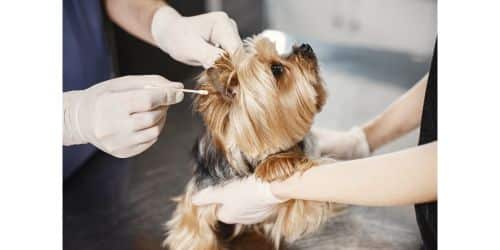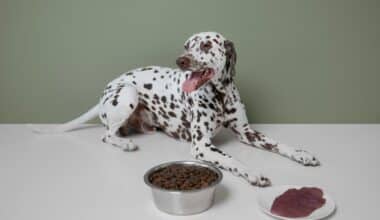When it comes to our canine friends’ health and happiness, their skin condition is critical. Folliculitis, an inflammation of the hair follicles, is a frequent skin problem in dogs. In this comprehensive guide, we will explore the causes, symptoms, and treatments for folliculitis in a dog. We’ll cover all you need to know to assist your canine pet in finding relief and restoring the luster of their coat, from home treatments to specialized shampoos.
What is Folliculitis?
Folliculitis is an inflammation of the hair follicles that can affect both people and dogs. It is frequently caused by bacterial or fungal infections in dogs. The condition can take the form of superficial bacterial folliculitis or deeper forms like deep folliculitis or furunculosis.
Causes of Folliculitis in Dogs
Several factors can lead to the development of dog folliculitis. Allergies, parasites, poor grooming practices, hormone imbalances, and underlying skin disorders are examples of these. Bacterial folliculitis, in particular, is frequently caused by bacterial overgrowth on the skin.
Identifying Symptoms of Folliculitis in Dogs
Early detection of folliculitis in dogs is critical for effective treatment. Redness, swelling, pustules or pimples around hair follicles, itching, hair loss, and a bad stench emerging from the affected area are all symptoms. It is vital to note that the degree and location of the folliculitis can affect these symptoms.
Differentiating Folliculitis from Other Skin Conditions
Folliculitis is related to other dog skin disorders such as hot spots, ringworm, and allergic reactions. A veterinarian’s accurate diagnosis is required to differentiate folliculitis from these illnesses and identify the proper treatment.
Folliculitis Dog Treatment
Folliculitis, or inflammation of the hair follicles, can cause discomfort and irritation in our furry friends. If your dog has folliculitis, it is critical to seek effective therapy to ease symptoms and encourage healing. In this post, we will look at many treatment options for folliculitis in dogs, such as medicinal interventions, home cures, and preventive measures. By understanding these treatments, you can help your furry friend find relief and restore their skin’s health.
#1. Seeking Veterinary Care
When you suspect folliculitis in your dog, consult a veterinarian immediately for an accurate diagnosis and suitable treatment. To diagnose the underlying cause and severity of the ailment, a veterinarian will perform a thorough examination, which may include skin scrapings, bacterial cultures, or biopsies.
#2. Medications for Folliculitis
Veterinary treatment for folliculitis often involves the use of medications such as antibiotics or antifungal drugs, depending on the cause of the inflammation. Your veterinarian will establish the quantity and duration of these treatments, which can be taken orally or topically.
#3. Steroid Therapy
Corticosteroids may be prescribed by your veterinarian in some cases to reduce inflammation and relieve itching and pain caused by folliculitis. However, given the possibility of negative effects, the usage of steroids should be carefully monitored and provided under veterinary supervision.
#4. Ointments and Topical Solutions
Your veterinarian may advise you to use topical treatments or ointments to relieve discomfort and promote healing. Antimicrobial sprays, medicinal creams, or calming lotions may be used to relieve inflammation and prevent secondary infections.
#5. Professional Grooming and Maintenance
Professional groomers can help manage folliculitis by giving specialized care such as medicated baths or unique grooming techniques. Regular professional grooming sessions can help preserve skin health and avoid folliculitis recurrence.
Superficial bacterial Folliculitis Dog
Superficial bacterial folliculitis is a frequent skin ailment in dogs that involves bacterial overgrowth on the skin causing inflammation of the hair follicles. It can cause redness, pustules, papules, itching, and pain in the affected dog. Here are some treatment options for dogs with superficial bacterial folliculitis:
Antibacterial Shampoos: Using antibacterial shampoos on the skin can help minimize bacterial overgrowth and relieve symptoms. Look for shampoos that contain antibacterial chemicals such as chlorhexidine or benzoyl peroxide.
- Topical Antibiotics: To directly target the bacteria on the damaged skin, your veterinarian may prescribe topical antibiotics in the form of sprays, creams, or ointments.
- Oral Antibiotics: Oral antibiotics may be required in more severe or recurring episodes of superficial bacterial folliculitis. Based on the specific bacteria implicated and your dog’s overall health, your veterinarian will select the proper antibiotic and dosage.
- Preventive Measures: Addressing any underlying conditions that contribute to bacterial overgrowth is critical for long-term prevention and management of superficial bacterial folliculitis. This may include regular bathing with a gentle, antibacterial shampoo, maintaining a clean and dry environment, managing allergies, and addressing any potential immune system deficiencies.
- Veterinary Guidance: Always seek the advice of your veterinarian for an appropriate diagnosis and treatment plan customized to your dog’s specific needs. Additional diagnostic tests, such as skin scrapings or bacterial cultures, may be recommended to identify the specific bacteria causing the folliculitis and guide therapy recommendations.
Folliculitis Dog Home Treatment
Here is the most effective home treatment for bacterial Folliculitis in Dogs:
#1. Keeping Cleanliness and Hygiene
Bathing with a gentle, hypoallergenic shampoo regularly can help cleanse the skin and eradicate microorganisms. Make sure the shampoo is designed exclusively for dogs and is free of harsh chemicals that could irritate the problem.
#2. Topical Solutions and Warm Compresses
Warm compresses applied to the affected area might help reduce inflammation and facilitate healing. Furthermore, your veterinarian may advise you to use topical treatments or antibiotic sprays to relieve discomfort and prevent additional infection.
#3. Dietary Guidelines
Dietary changes may be effective in some circumstances for dogs with persistent folliculitis. Consult your veterinarian for advice on a healthy diet that promotes skin health while also addressing any underlying allergies or sensitivities.
#4. Environmental Management
Environmental adjustments can assist in lowering the likelihood of folliculitis. Keep your dog’s bedding clean and free of potential irritants, and maintain a thorough grooming practice that includes frequent brushing and removal of matted hair.
#5. Consultation with a Veterinarian
While home treatments might be beneficial, a veterinarian should be consulted for a proper diagnosis and treatment plan. They can evaluate the severity of the folliculitis, identify any underlying reasons, and, if necessary, prescribe suitable drugs or therapies.
Folliculitis Dog Shampoo
Using a folliculitis-specific shampoo can considerably speed up the healing process. These shampoos frequently contain antimicrobial chemicals like chlorhexidine or benzoyl peroxide, which aid in the fight against bacterial or fungal overgrowth.
Recommended Shampoo Brands
Several respected brands sell shampoos intended exclusively to treat folliculitis in dogs. Look for dermatologist-recommended products that are pH-balanced and free of harsh chemicals or additions that may irritate the skin.
Proper Shampoo Application
Follow the manufacturer’s or your veterinarian’s directions when using a folliculitis-specific shampoo. Lather the shampoo into your dog’s coat thoroughly, paying special attention to the affected areas. Rinse the shampoo well and gently dry your dog.
Best Folliculitis Dog Shampoo
When choosing the best folliculitis dog shampoo, consider your dog’s individual needs, the underlying reason for the folliculitis, and any advice from your veterinarian. Here are a few common shampoos that are frequently advised for dogs suffering from folliculitis:
#1. Veterinary-prescribed Medicated Shampoos:
- Chlorhexidine Shampoo: Chlorhexidine is an antibacterial shampoo that can help manage bacterial or fungal infections linked with folliculitis. Veterinarians frequently prescribe it for a variety of skin disorders.
- Benzoyl Peroxide Shampoo: Benzoyl peroxide can help reduce bacteria while also removing excess oil and debris from the skin. It is frequently used in the treatment of folliculitis and other skin disorders in dogs.
#2. Hypoallergenic Shampoos:
- Oatmeal Shampoo: Oatmeal shampoos are well-known for their hydrating and calming effects. They are frequently advised for dogs with sensitive skin because they can help alleviate itching and irritation caused by folliculitis.
- Aloe Vera Shampoo: Shampoos containing aloe vera have a calming impact on the skin and can help relieve the discomfort caused by folliculitis.
#3. Shampoos with antiseptic properties:
Tea Tree Oil Shampoo (Diluted): Tea tree oil contains natural antiseptic properties that can aid in the treatment of bacterial and fungal illnesses. Because pure tea tree oil can be hazardous to dogs, it should be administered in diluted form. Consult your veterinarian about the proper dilution ratio.
Remember to follow the shampoo’s directions, including dilution and contact time, and consult your veterinarian before using any specific shampoo on your dog.
Home Remedies and Homeopathic Treatments
#1. Warm Compresses
Warm compresses applied to the affected areas can help calm inflammation, reduce pain, and improve healing. Several times a day, gently press a warm, moist towel against the afflicted skin for a few minutes.
#2. Aloe Vera Gel
Aloe vera gel’s inherent characteristics make it a soothing and healing agent. To relieve itching and encourage healing, apply a thin coating of pure aloe vera gel to the damaged regions of your dog’s skin.
#3. Coconut Oil
Coconut oil has antibacterial qualities and can be used topically to treat bacterial or fungal infections caused by folliculitis. Apply a small amount of coconut oil to the affected areas, ensuring your dog does not excessively lick it off.
#4. Epsom Salt Baths
In dogs with folliculitis, Epsom salt baths can help ease itching and reduce inflammation. Bathe your dog in warm water with a small amount of Epsom salt dissolved in it for 10-15 minutes. After that, thoroughly rinse.
#5. Herbal Remedies
Some herbal medicines, such as calendula, chamomile, or tea tree oil (diluted), have anti-inflammatory and antibacterial characteristics that can help with folliculitis treatment. However, before utilizing herbal medicines on your dog, contact a veterinarian or holistic practitioner.
Preventive Measures and Long-Term Management
#1. Regular Bathing and Grooming
Bathing and grooming regularly are vital for preventing folliculitis. To cleanse the skin and remove bacteria or allergies that can lead to inflammation, use a gentle, hypoallergenic shampoo designed specifically for dogs.
#2. Allergen Management
Identifying and treating probable allergens is critical for avoiding folliculitis in allergic dogs. This could include dietary adjustments, environmental changes, or avoiding specific substances that cause allergic reactions.
#3. Parasite Prevention
Use veterinarian-recommended flea and tick preventives regularly to protect your dog from parasites that can cause skin irritations and infections that lead to folliculitis. Consult your veterinarian about the best preventive measures for your dog’s needs.
#4. Nutritious Diet
A balanced and healthy food for your dog is critical for overall skin health. To encourage a healthy coat and prevent the danger of skin disorders such as folliculitis, make sure their food includes high-quality proteins, vital fatty acids, and vitamins.
#5. Stress Reduction
Stress can compromise the immune system, making dogs more prone to skin disorders. Reduce stressors in your dog’s environment, give them plenty of exercise and mental stimulation, and offer them a peaceful and soothing setting.
Folliculitis in dogs is treatable with a combination of veterinarian care, home remedies, and preventive measures. You can establish the underlying cause of folliculitis and develop a specific treatment strategy for your dog by working together with your veterinarian.
Incorporating home treatments and preventive measures can also help control symptoms, promote healing, and avoid recurrences of folliculitis. To safeguard your pet’s safety and well-being, always check with a veterinarian before beginning any treatment or using home remedies.
How does a dog get folliculitis?
Dog folliculitis can occur owing to a variety of reasons that change the usual balance of the skin and hair follicles. The following are some of the most common causes of folliculitis in dogs:
- Bacterial Infection
- Fungal Infection
- Parasitic Infestations
- Allergies
- Trauma or Irritation
- Hormonal Imbalances
It should be noted that the underlying cause of folliculitis varies from case to case. A comprehensive examination and consultation with a veterinarian are required to determine the source of your dog’s disease and develop a suitable treatment strategy.
What antibiotics are used to treat folliculitis in dogs?
The medications used to treat folliculitis in dogs are determined by the severity of the ailment, the bacteria suspected or identified as causing the infection, and the veterinarian’s professional judgment. Here are some antibiotics that are often used to treat folliculitis in dogs:
- Cephalexin
- Clindamycin
- Amoxicillin/Clavulanic Acid
- Enrofloxacin
- Tetracycline
What is the fastest way to cure folliculitis?
The speed of recovery from folliculitis can vary depending on the severity of the condition, the underlying cause, and the individual response to treatment. While there is no single “fastest” way to cure folliculitis, here are some measures that can help promote healing and speed up the recovery process:
- Consult a Veterinarian
- Follow Medication Instructions
- Maintain Good Hygiene
- Prevent Further Irritation
- Address Underlying Factors
- Follow-up with Veterinary Care
Conclusion
Folliculitis can be a discomforting and frustrating condition for dogs, but with the right knowledge and proactive measures, it can be effectively managed. From home remedies to specialized shampoos and veterinary care, there are various options available to treat and prevent folliculitis in dogs. Always remember to consult with a veterinarian for an accurate diagnosis and guidance tailored to your dog’s individual needs. By prioritizing their skin health, you can help your furry friend find relief and restore their coat’s radiance.
Related Articles
- Why Is My Dog Shaking When He Breathes In?
- Should I Put My Dog Down with Vestibular Disease?
- How to Treat a Corneal Ulcer in Dogs
- What Does It Mean When a Dog Coughs Up Blood?






